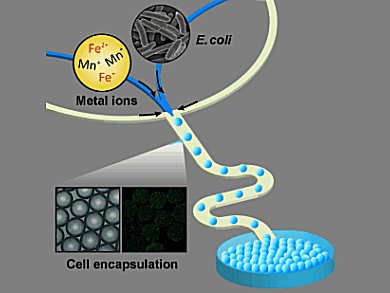Homeostasis endows microbes with an intrinsic ability to assemble metal ions to form a metal nanoparticle inside. This nanoparticle synthesis strategy inspired from nature can be adapted by using microorganisms as a nanoparticle factory under mild conditions. It has advantages over the conventional chemical methods, which require high temperatures, toxic reagents, and large energy sources. A limitation is the lack of control over the particle size. Heterogeneous nanoparticles are mainly produced.
Sang Yup Lee and Tae Seok Seo, Korea Advanced Institute of Science and Technology (KAIST), Daejeon, demonstrate a microfluidic droplet generator that uniformly encapsulates an equivalent number of engineered Escherichia coli cells and the same Fe and Mn metal ion concentrations in identically sized droplets.
This precise controllability for microenvironments enables the recombinant E. coli cells to assemble the metal ion under quite similar conditions, resulting in homogeneous biogenic FeMn magnetic nanoparticles. The heterogeneous size distribution of the conventional bulk-phasebased biogenic nanoparticle could be overcome by this system. The study also demonstrates the use of the droplet as a nanoliter bioreactor in which the cells were incubated and worked for nanoassembly.
Since the scale-up of the droplets is currently under way, it is a promising method to produce homogenous biogenic nanoparticles in an eco-friendly, cost-effective, and highly parallel process.
- Homogeneous Biogenic Paramagnetic Nanoparticle Synthesis Based on a Microfluidic Droplet Generator,
Jae Hwan Jung, Tae Jung Park, Sang Yup Lee, Tae Seok Seo,
Angew. Chem. Int. Ed. 2012, 51.
DOI: 10.1002/anie.201108977




